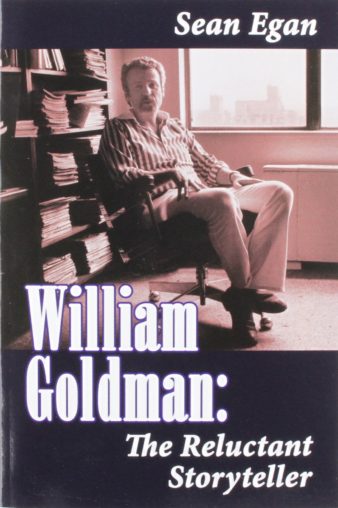 By SEAN EGAN (BearManor Media; 2014)
By SEAN EGAN (BearManor Media; 2014)
As of late 2018 this is the only book-length study that exists of the life and work of the late William Goldman. WILLIAM GOLDMAN: THE RELUCTANT STORYTELLER is a fairly good, reader-friendly overview, but it’s marred by author Sean Egan’s attitude toward his subject’s output—quite simply, Egan doesn’t appear to much like or understand Goldman’s writing. That’s evident in the title, which ostensibly refers to Goldman’s famously curmudgeonly, self-deprecating nature, but based on Egan’s withering critiques of his novels the term “Reluctant Storyteller” also seems like a verdict on Goldman’s abilities.
Certainly Egan seems to admire Goldman’s range and longevity, making sure to complement the “extraordinary breadth of his prose vision.” Yet of Goldman’s 17 novels the only ones Egan seems to really like are FATHER’S DAY (1971), THE SILENT GONDOLIERS (1983) and THE COLOR OF WATER (1984), with Goldman’s debut novel THE TEMPLE OF GOLD (1957) apparently “compromised by exigency.” Of his second novel Egan is even more withering, stating “the fact that YOUR TURN TO CURTSY, MY TURN TO BOW (1958) was even published at all is rather puzzling.” NO WAY TO TREAT A LADY (1964) is dismissed as “exploitive and unpleasant,” BOYS AND GIRLS TOGETHER (1964) as “tedious (and) trashy” while THE PRINCESS BRIDE (1973), the most beloved of Goldman’s novels, “doesn’t work on any level.” The author doesn’t go much easier on Goldman’s later novels like CONTROL (1982), HEAT (1985) and BROTHERS (1986)—just the opposite, in fact—and nor is he too sanguine about his film scripts. A BRIDGE TOO FAR’s screenplay is blamed for the fact that “the finished film has no heart,” THE PRINCESS BRIDE film adaptation is dismissed as “talky and static” and MAVERICK as an “exercise in slick emptiness.”
The author’s major problem with Goldman’s work, it seems, comes down to a simple culture clash. Sean Egan is British while Goldman was nothing if not quintessentially American, and Egan’s critiques tend to pivot on this aspect: “he is unable to write with a mind-set except that of a contemporary American,” “this sometimes leads to passages incomprehensible to the uninitiated and non-American,” “Goldman casually litters the text with first-name references to American celebrities, which one imagines will even puzzle some Americans, let alone non-US citizens,” etc.
Also included are some select biographical details, bequeathed by extensive interviews with Goldman himself. All the highlights of his life are covered, such as the suicide of his father when Goldman was fifteen, the unexpected sale of his first novel to a major publishing house after years of rejection, his failed attempt at a Broadway career in the early sixties, his accidental introduction to screenwriting that occurred when actor Cliff Robertson mistook the manuscript of NO WAY TO TREAT A LADY for a film treatment, his lengthy stretch of unemployment in the early 1980s, and his abrupt abandonment of novel writing after the publication of BROTHERS. Of his work Goldman has little to say, being “totally instinctive” in his approach, and nor is he too forthcoming about his personal life, giving us only the barest outlines of his 27 year marriage, which broke up in in the late 1980s for reasons that are left unclear.
One wonders what Goldman, who never had a good word to say about critics (who he characterized as “whores and failures”), might have thought about this book, which is nothing if not critical. It’s certainly not any Goldman fan’s idea of an essential resource, but in the absence of any others I guess it will have to do.
